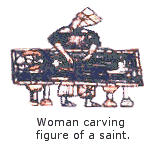
Gothic Design
Learn More.
| HOME Feature Articles Stone Carver's Tour Virtual Cathedral Cathedral Tours Gothic Field Guide GOTHIC GEOMETRY Virtual Abbey Medieval Art Tours Castle Tours Links Resources About The Site FAQ |
|
The Virtual The Stonecutters: The Trade
Stonecutters, in particular, wasted no time in organizing and virtually monopolizing the trade in towns and cities throughout Europe. With a code of business ethics established, rules were rigidly enforced for upholding the guild's reputation. In return, a loyal member could expect steady work, and his expenses met - along with those of his family - should he become sick or injured. Boys
were ready for acceptance into the guild at the age of 11 or 12.
Entry was easier if they had a relative in the business - for
example, a father who With
training completed, apprentices were eager
to ply the trade as journeyman, striking out on their own to work
for higher wages, with more varied projects in other cities and
with other masters.
Experienced journeymen eventually applied for the position of master after passing a rigid guild exam in which they submitted a 'master-piece' of stonecutting to the guild for acceptance. The cycle was completed when a new master set up his own shop and sought out apprentices. From these ranks of master stonecutters often came the Gothic engineers and master builders.
Women
were occasionally employed as stone carvers, although not officially
accepted into the guild. Legends
persist about Sabina Von Steinbach, who assisted her father in
the building of Strasbourg Cathedral. Very real images in stained
glass depict at least one woman in the highly respected role of
stonecarver at Bourges Cathedral (above).
Chapter
II. The Stained Glass Painters
|
Sponsored
Links
copyright © 2017
 In
the 12th century, the medieval guilds grew to rest the power once
tightly held by the feudal land barons, and in so doing heralded
economic freedom not known until then.
In
the 12th century, the medieval guilds grew to rest the power once
tightly held by the feudal land barons, and in so doing heralded
economic freedom not known until then.

 In
general, the 'high crafts' (stone, wood and ironcrafters) received
a better salary rate than in other trades, with stonecutters among
the highest paid.
In
general, the 'high crafts' (stone, wood and ironcrafters) received
a better salary rate than in other trades, with stonecutters among
the highest paid.